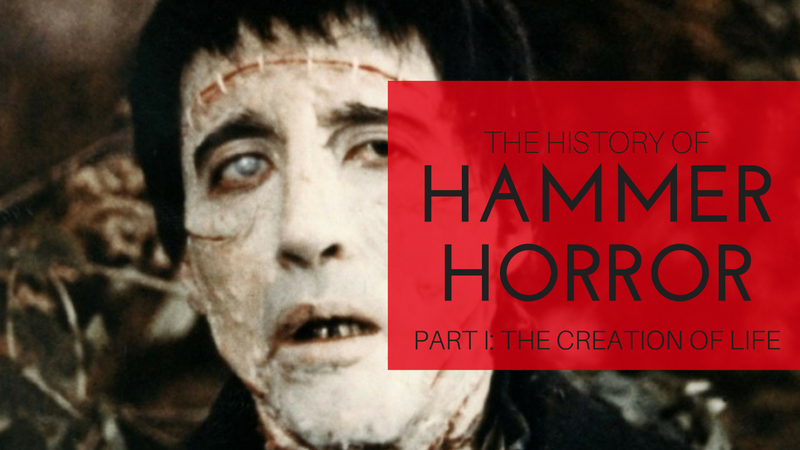
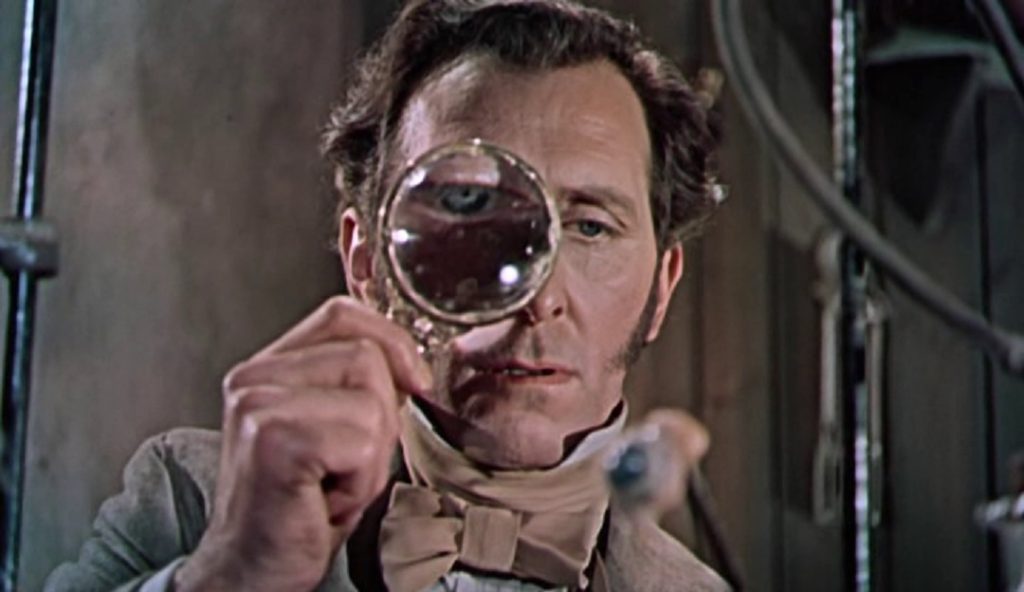
Hammer Pictures has been around for over 80 years. I’m a late-comer to their films when it comes to that timeline. I am, however, a huge fan. I remember catching bits and pieces of these movies over the years. Even as a kid I was entranced by the storytelling and the performances, or at least entranced enough to remember them.
When I really decided to dive back into the Hammer films a few years ago I realized what a rich history there was. Because of that I wanted to write this series to discuss the studio, its ups and downs and major developments, while also delving into some specific films they put out. Films which were either groundbreaking, underrated or kind of crappy. I’ll also include a section at the bottom with some suggestions of other movies to check out, either Hammer productions I’m not discussing in one of the main articles or just some movie that came to mind while I was writing.
When Hammer Pictures started out in 1934 it was a basic small-time studio. They produced mostly comedies and thrillers, cheap B-movies which were easy to film and finance. Shortly after starting up, and only five films in, Hammer had to file for bankruptcy. At this point the name was just a name, but it’s still crazy to think how many times the history of horror films as we know it could have been altered or derailed based on one company alone.
Hammer was bought out by its distribution company and made films off-and-on throughout the 40’s and early-50’s — sidetracked a bit by something called World War II — that mostly stuck to comedies, crime, thrillers and, most importantly, sci-fi. The studio slowly racked up moderate successes but it wasn’t until the 1950s that Hammer made two genre-defining decisions: making a film adaptation of Nigel Keane’s The Quatermass Xperiment and hiring Terence Fisher.
I’ll get to Quatermass in a later article, but Terence Fisher is one of the biggest creative forces behind Hammer as a brand and a piece of pop culture. When Hammer decided to film an adaptation of Frankenstein they brought him aboard and his direction was important and influential. Hammer took horror movies, which some had argued wouldn’t work as well removed from the striking shadows of black and white, to a place of lush backgrounds and stark pops of colour.
Hammer ended up basically creating Gothic horror. They also created two horror icons who live on as legends to this day: Peter Cushing and Christopher Lee.
The Curse of Frankenstein (1957)
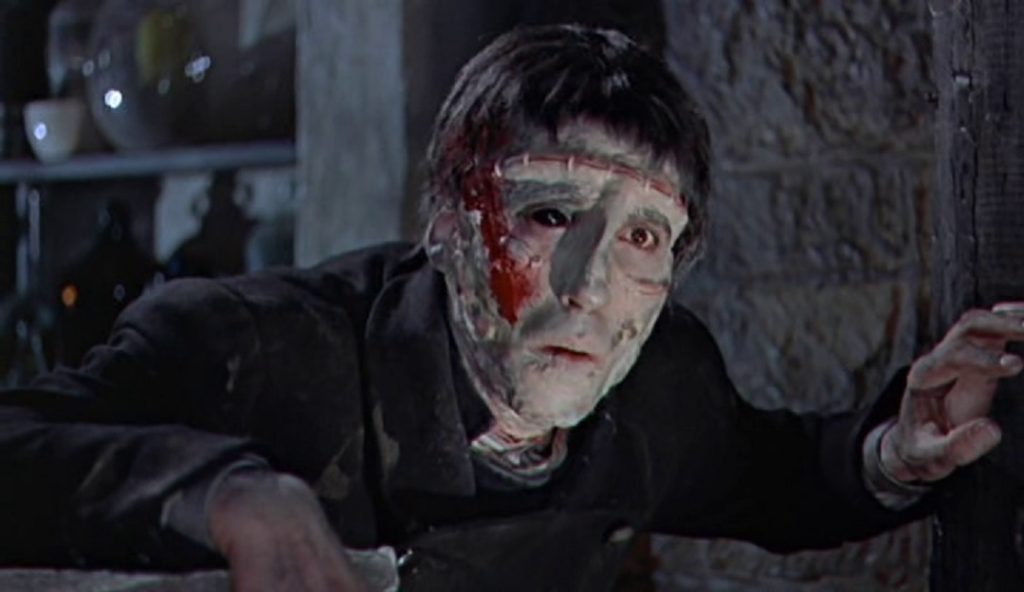
If you ask any horror fan to name some acting icons in the genre it’ll vary depending on age. You’ll get Robert Englund and Doug Bradley. You’ll get a Jamie Lee Curtis or an Anthony Perkins. But I guarantee you don’t leave the top ten without either Christopher Lee or Peter Cushing getting name-dropped.
It’s surprising that an entire legacy is built on Hammer looking for someone who was big. Christopher Lee happened to fit the bill, and it was him taking the role that not only created a lifelong friendship with his costar but also the best “creature” performance in the entire Hammer Frankenstein franchise. Lee lumbers and intimidates, as you’d expect, but there’s a wounded vulnerability to him. You feel bad for the creature while being scared of him, which most good Frankenstein adaptations strive for and only the best accomplish.
It does help when Dr. Frankenstein is a complete asshole though.
Peter Cushing’s Dr. Frankenstein is as close to definitive as they come. I know it’s English Lit 101 to point out that Victor Frankenstein is the “bad guy” of the story, but . . . he is. And Cushing owns that. We see him as rude, dismissive, slightly lecherous and, above all else, scientifically driven. He’s a guy who believes that a few sacrifices are worth it for the greater good, which is classic good-intentioned-villain fodder. The problem with casting Cushing is that few can actually hold their own with him. Robert Urquhart as Dr. Paul Krempe tries but he’s stuck with a stuffy character who comes off as flighty and full of himself. Most of the cast turns in fine but unexceptional performances save for Cushing and Lee. Which is especially impressive for Lee, considering he has no dialogue and quite a few restrictions.
Hammer was threatened to stay far away from anything specific to Universal Picture’s 1931 Frankenstein which makes the makeup and effects even more impressive when you’re showing up late to the game. I grew up with Karloff’s creature ingrained in me, as most people who are alive today did, which is a lot to live up to. It’s impressive how much a pea coat, some crackly blue facial prosthetics and a wonky eye can accomplish. I was even more astonished when I found out the effects artist basically redid Lee’s face daily without a mold or a guide.
Curse is a seminal work. It was a huge success that helped push Hammer to the forefront of horror filmmaking. The production design is fantastic, creating a memorable laboratory without being able to imitate anything from the Karloff version is impressive. The use of colour was revelatory at the time, showing filmmakers, critics and moviegoers how much blood can pop when it’s splashed across the screen.
The Revenge of Frankenstein (1958)
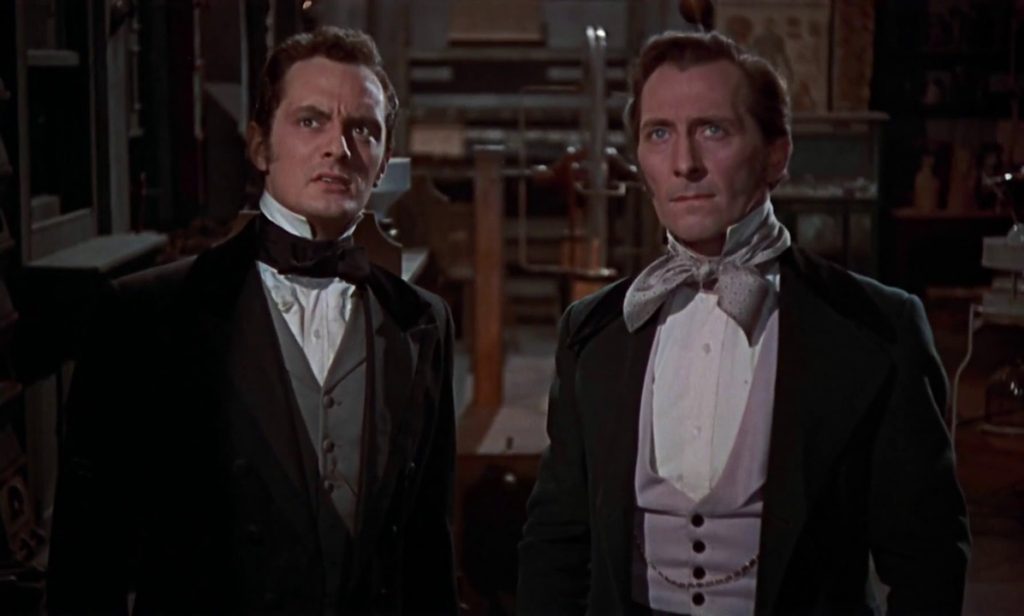
The Revenge of Frankenstein is a really interesting sequel. First of all, I love the reversal of the ending of Curse. It reminds me of some old serial like The Phantom Creeps. It also builds off of what came before it, both through the story and the character of Frankenstein himself. This film tries to transition him into more of an antihero, a misunderstood genius who should be pitied for what he does instead of hated.
Revenge does this by showing Frankenstein trying to help people, almost like a penance. A huge portion of that is self interest, mind you, what with him freely helping himself to any of the patients’ extremities he deems unnecessary. But still, he gets points for trying. There’s also Karl, his hunchbacked assistant who volunteers to become the “creature”. There’s more to what Frankenstein is doing this time than just bald-faced hubris.
This also marks the first time Frankenstein has a willing, enthusiastic assistant. It’s actually pretty refreshing after the stuffiness of Paul from the original.
What Revenge lacks in creature mayhem — even though Michael Gwynn does a fantastic job bringing pathos to the part — it more than makes up for with its examination of Frankenstein himself. He gets punished in this movie for the sins of the first one, but the filmmakers never lose sight of the fact that we don’t really want a morals lesson. We want to see Cushing do what he does best.
Maybe the best part of the movie is the very end, which gives us a hell of a hook for the next sequel. Unfortunately, it’s basically squandered.
The Evil of Frankenstein (1964)
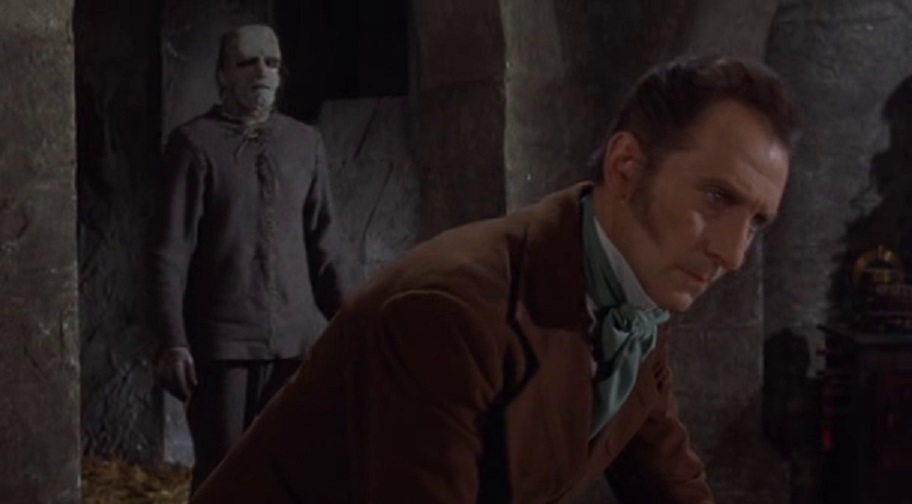
The character of Baron Victor von Frankenstein is an interesting one. As I mentioned before, he’s a total bastard. The Evil of Frankenstein attempts to rehabilitate the character a bit, becoming both a continuation of the series and a reboot of the films that came before it. Hammer also got a little cheeky and tried to incorporate some design and story elements from the Universal Frankenstein movies. They try to shift our thoughts of Frankenstein from villainous protagonist to straight-up misunderstood rascal. The redemption stuff was subtler and worked better in the previous film, Revenge.
Frankenstein works fine as a misunderstood hero, I guess, but it’s way more fun to see him as a complete asshole who’s buoyed almost completely by Cushing’s charisma. It doesn’t help that the film is fairly slow and melodramatic without being as interesting as Revenge and almost never reaches the level of thrills the other movies do. There’s some great production design, as usual for Hammer, and one solid set piece in the finale when Frankenstein’s lab is set ablaze. Unfortunately that finale leads to a sudden thud of an ending, without having a point of a punchline. It just ends.
The creature design is also pretty lackluster. I can see why they wanted to play with the iconic Boris Karloff look: giving the creature a square face, flat top, large boots, lumbering movements and a fear of fire. What they ended up with, however, was something that looked sort of gruesome up close but generally had a papier-mâché/bad Halloween costume look to it.
Overall, Evil is the worst movie in the Frankenstein franchise. Not coincidentally, it’s also the only one not directed by Terence Fisher. Its biggest sin is how boring it is. Hammer brought new life to horror movies and Evil feels like a movie anyone could have made.
Frankenstein Created Woman (1967)
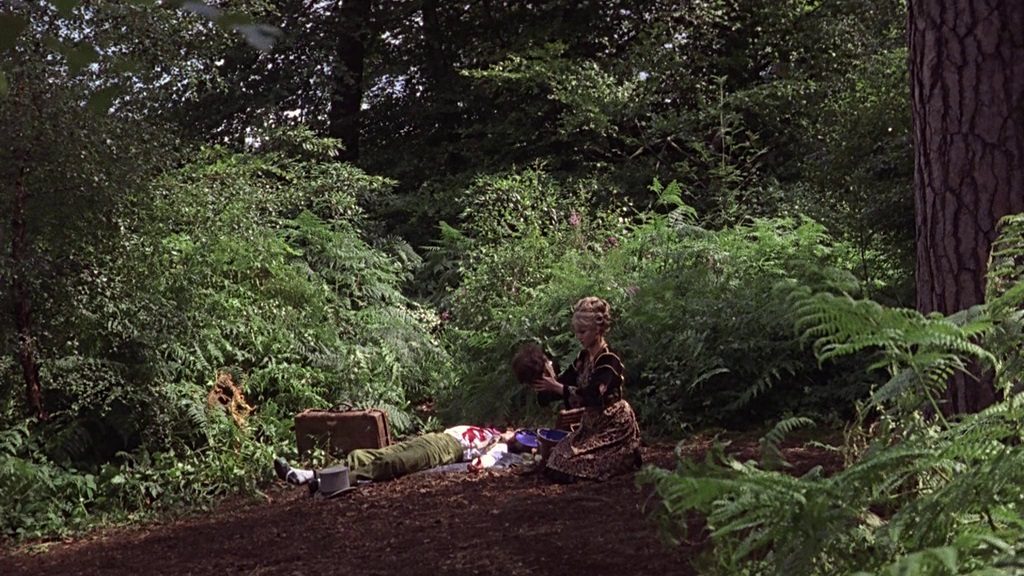
Now this movie is more like it.
Hammer’s horror rep was well-established by this point, and it shows. Frankenstein Created Woman seems almost easy, but at the same time it’s grotesque, interesting and also fun. While the film wasn’t very well-received at the time there’s been a bit of a re-evaluation and one of the things that gets mentioned — by noted Hammer aficionado Martin Scorsese, among others — is that Woman is the first movie in the series to deal with the soul. Hammer’s answer to the question is as twisted as you’d expect.
One of my favourite things about this movie is Baron Frankenstein himself. Cushing is always a ridiculously watchable actor. You can spend whole scenes with him just silently messing with doo-dads in his lab and be completely entranced. At this stage in the game Cushing’s performance as Frankenstein is old hat without becoming tired and worn. He’s just comfortable. They also do some course correction from Evil and almost bring his character more into line with Cushing’s performance as Abraham Van Helsing from Hammer’s Dracula series. Frankenstein also brings a sense of fun to the proceedings. He’s very much a Jack Sparrow character: the quirky, well-acted main character who’s basically a supporting actor for the main storyline. He’s in top form during the trial scene, dismissively flipping through the Bible and showing brash disdain for the police. He even gets a sort of non-sequitur prologue where he’s brought back to life after being frozen — a literal “cold open” — as an experiment. The man creates an invisible force field in this movie, for God’s sake!
Overall, the best thing Woman does for the franchise is return it to the pulpy fun of the original. It had been almost ten years since Curse, and while I enjoyed Revenge, both it and Evil leaned too heavily on the melodrama. This movie leans into the lurid, presenting a totally memorable “monster” and giving it some truly detestable people to off. The film’s third act is more of a slasher or revenge thriller than a gothic horror. In fact, I wouldn’t be surprised at all if movies like I Spit on Your Grave and Friday the 13th Part 2 — AKA the best Friday the 13th — were heavily influenced by this film.
Frankenstein Must Be Destroyed (1969)

There Frankenstein goes, back to his old scoundrel ways. A little too much, as it turns out, but I’ll talk about that in a bit . . .
Frankenstein Must Be Destroyed makes a few big missteps which puts it near the bottom of the series. First of all, it’s fairly by-the-numbers. Hammer Pictures had a style and a reputation and they knew what they were doing, but you can’t help but feel a sort of “let’s knock out another Frankenstein film, shall we?” atmosphere around it. Obviously there’s still the immaculate production design of most Hammer features: mist-shrouded streets, cobweb strewn mansions and cherry red blood. It’s most of the stuff surrounding that which lets the movie down.
Cushing excels, as expected. The role is much more in line with the original movie. He’s back to being a mean bastard, doing anything and forsaking anyone in the pursuit of bringing some dead person back to life. Honestly, you’d think at this point it wouldn’t even be worth blackmailing a lovely young couple of bad actors for something so simple. At least Woman dealt with the soul and invisible force fields. A simple brain-for-brain transplant is the Jiffy Lube 10 Minute Oil Change of Frankenstein procedures. This creature hews a little closer to the book’s version, being loquacious and a little sympathetic. Which brings us back to Cushing being the real villain of the piece.
Look, I’ve made it clear that I enjoy Frankenstein as an asshole. When he’s brash, determined and dismissive of those around him it’s entertaining. Cushing’s bird-like focus and easy charisma can carry that. Apparently my goodwill runs out at an unnecessary rape scene. I was a little relieved when I found out it was filmed under studio pressure with Veronica Carlson, Peter Cushing and Terence Fisher all heavily objecting. At least they understood how gross and pointless it was. That doesn’t stop the fact that it’s still in the movie though.
To the benefit of Destroyed, things generally come together well in the finale. As much as the film leading up to it is both muddled and by-the-numbers there’s some satisfaction in seeing the plot all come together. I didn’t really know I wanted to see Frankenstein get Home Alone-ed by his own creation, but here we are. It doesn’t seem like a coincidence, however, that Destroyed ends as as abruptly and in a similar manner as Evil, the actual worst movie in the franchise.
The downside is that they managed to make a movie where I was glad that Cushing’s Frankenstein didn’t get away, which should basically never happen.
Frankenstein and the Monster from Hell (1974)
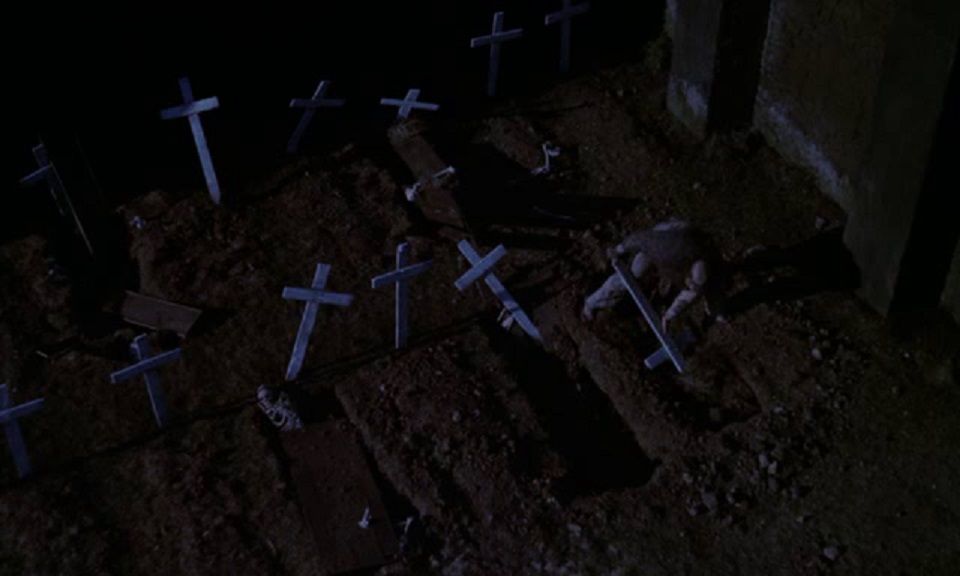
The Frankenstein series goes to show that a great name doesn’t necessarily a great movie make. Frankenstein and the Monster from Hell is a solid, middle-of-the-pack entry in the franchise which is a bit of a disappointment for a finale. For some reason the movie has always felt out of place in the mid-1970’s, even though it and the other films in the franchise are period pieces.
Monster has a lot of the same elements that the previous movies contained: an over-eager young assistant, Frankenstein hiding under a pseudonym, bumbling and superstitious authority figures. This Frankenstein is very much in the mold of the scientifically curious antihero of Revenge and Woman as opposed to the total asshole of Curse and Destroyed.
An interesting but troubling trend which is obvious once you get to the end of these movies is the misogynist streak that runs through each film. Some of that has to do with the times they’re depicting, but there’s rarely any commentary or subversion of it. Except for Woman, but even it has a male’s voice guiding the female character. Monster cements the trend by having the series’ second mute supporting female. A voiceless woman is a little excessive once, twice and it’s bordering on farce.
Monster also follows the unfortunate trend of surrounding Cushing with uninteresting actors. His assistant is another bland, blonde waif and David Prowse’s — that’s right, one-fifth of Darth Vader himself — “Monster” is underwhelming. It’s basically a caveman costume. On the plus side, there are some interesting things going on with God and creation (the inmate, Frankenstein’s pause when contemplating creating life, etc.) but they don’t end up being too deeply explored. There’s also the finale, the end of the “Monster” itself. It’s the most truly horrific ending any of Frankenstein’s creations has met in these films.
What saves the film — and what basically saves even the worst of these films from being unwatchable — is Peter Cushing’s total and absolute commitment. He always manages to be serious without being po-faced, and funny without being farcical. His authority and easy familiarity with his sets and environment makes you just straight-up believe he’s Frankenstein.
(Small Sidenote: one of my favourite motifs throughout these films is the fact that any time Peter Cushing has a five o’clock shadow you know he was up all night messing with some spookies down in his lab. I couldn’t find a good place to fit this in, but seeing Cushing show up with a two-day beard in Monster after some brain surgery was like a warm blanket for me.)
Peter Cushing was one of the solid foundations that the Hammer Horror reputation was built on. He’s practically a living encapsulation of the production company. Very good, very British and never too good to class up some solid trash.
Or, in Cushing’s own words:
Who wants to see me as Hamlet? Very few. But millions want to see me as Frankenstein. So that’s the one I do.
Breathe New Life Into Hammer Horror
The only Frankenstein film by Hammer that I haven’t mentioned is 1970’s The Horror of Frankenstein. It’s the odd man out of the bunch, missing both Peter Cushing and Terence Fisher. The movie is basically a remake of The Curse of Frankenstein, retelling the original story with more deliberate sex and humour. It’s fine, but easily pales in comparison to the majority of the other entries.
Expanding outward from Hammer, I’d be remiss not to mention the original Universal monster movies. The best of the bunch, in my opinion, are Frankenstein, Bride of Frankenstein and The Wolf Man. There’s really no need to go into how important and influential those early movies were to the horror genre. If you haven’t seen any of those then go watch them immediately.
Coming Up in Part 2 . . .
Diving into the Dracula franchise and a deeper appreciation of Christopher Lee… as was his will.




One thought on “The History of Hammer Horror Part 1: The Creation of Life”